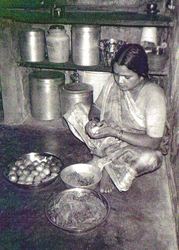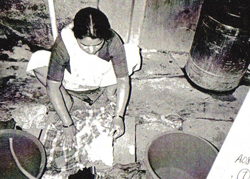
The opportunities and benefits of fair trade for workers in developing countries are increasingly on the minds of consumers with the introduction in 2010 of a new fair trade label for apparel products. Yet many do not understand the decades–long history of fair trade work, nor the expansive social and economic benefits that fair trade has already delivered to artisans producing handcrafted textile and apparel products for consumer enjoyment.
Fair trade offers one development model for artisans seeking a place in the global marketplace. Fair trade businesses engage in paying a fair wage, providing healthy and safe working conditions, promoting environmental sustainability, offering business training, and building long–term trade relations. Expanding artisans’ financial, human, and social capital lies at the heart of the fair trade model. Until now, critique of fair trade impacts has been hampered by a lack of in–depth analysis.

Artisans and Fair Trade: Crafting Development (Mary A. Littrell and Marsha A. Dickson, Sterling, Va.: Kumarian Press, 2010) presents a socio–economic analysis of the capabilities, livelihood, and quality of life for artisans who have had the opportunity to work under the fair trade model practiced by MarketPlace: Handwork of India. Founded in 1986 by sisters Pushpika Freitas and Lalita Monteiro, MarketPlace grew from roots in a modest sewing project for impoverished women in Mumbai, India. Today, more than 300 MarketPlace artisans produce Western–style apparel and household textiles with design inspiration and production techniques native to India. Two hallmarks distinguish MarketPlace products: Fabrics incorporate hand production, through dyeing, printing, or weaving; and each product is then embellished with hand embroidery that introduces striking points of emphasis. The apparel is marketed abroad through retail stores, catalogs, and the Internet.
Funding from the Earthwatch Institute and the Rockefeller Foundation allowed us to conduct extensive field research across a period of eight years in Mumbai and to develop a comprehensive analysis of the social, psychological, and economic impacts of the fair trade work. We share our findings gathered through interviews with more than 161 artisans who reside in several of Mumbai’s largest slums. A series of questions guided our exploration of:
From its inception, founder Pushpika Freitas insisted, “Our primary goal was to provide women with opportunities to earn a dignified living, reach their potential, and redesign the destinies for their children.” MarketPlace established a dual focus on generating income in the profit–driven global marketplace while also developing capabilities for the empowerment of low–income artisans. Two organizational arms, MarketPlace Bombay and SHARE (Support the Handicapped’s Rehabilitation Effort), provide direction to the business and social thrusts, respectively. In addition to technical and business training, MarketPlace artisans are privy to a variety of social programs offered through SHARE, including focus on women’s health, parenting, legal rights, gender issues, and intergenerational dynamics. In addition, each production unit carries out a social action project for addressing a community problem in its slum.
Women seek work at MarketPlace for a variety of reasons, including insufficient household income (often due to an ill or unemployed husband), widowhood or abandonment, and the strong desire to provide their children with a better life. Many women suffer regular physical and mental abuse from husbands and in–laws. For more than half of the women, MarketPlace offers a first job. Among others, previous at-home labor centered on stringing beads, making bindis (dot on the forehead), counting pills for dispensaries, or producing light bulbs.
MarketPlace work is organized in seven workshops. One-quarter of the women work as tailors, sewing garments on machines housed at the workshops. However, the majority of women walk to their workshops to pick up their embroidery assignments and return home to finish the hand embellishment. Women add textile production to an already time–intensive and physically demanding set of daily household tasks. Across a day, artisans intersperse five to six hours of MarketPlace work around six to seven hours devoted to stockpiling water that is available only in the early morning from a neighborhood tap, bathing and religious rituals, and preparing and escorting children to school. Yet another four to five hours daily is devoted to food preparation, including daily shopping for ingredients (few have refrigeration), cutting vegetables and grinding spices, cooking chapattis, and preparing sauces.
Clearly, the women have few hours for sequential, uninterrupted MarketPlace production. Flexible hours and the opportunity to work at home are essential to women who are often solely responsible for managing their households. These women are simply not free to leave their homes for the long periods of time that would be demanded by other forms of employment such as domestic work as a maid or cook or factory work. MarketPlace’s approach to production matches the cultural context for the lives of many women in the slums of India.
International development leader Robert Chambers (1997) contends that capability enhancement serves as the foundation for increasing livelihood (income) and establishing enhanced quality of life. As part of working at MarketPlace, the women have acquired a broad range of skills, from speaking up and going outside their slums for the first time, to talking on the telephone, to using public transportation for procuring supplies and making deliveries across Mumbai.

Because so many of the women live in abusive households, the workshops provide a critically important physical and psychological refuge. Women frequently volunteered that “I can talk about anything here” or “I had no one to talk with before I came here.” These comments speak to the relief from household tension the women feel when at the workshops and to their newly acquired inner resources for supporting other women who are living in like circumstances. As social capacity is expanded through enhanced capabilities, a window to the world outside the slum has opened for the MarketPlace women.
Artisans contributed on average 40 percent of the household’s financial resources. Not infrequently, the remainder was split between several other household members, leaving the artisan as the largest household contributor. Even with the MarketPlace income, most households struggled to meet their basic minimum needs for housing, food, transportation, and utilities. Income from MarketPlace fluctuates across the year, due to seasonal demand for clothing from the U.S. market. For those women who are sole household providers, the amount and irregularity of income is clearly insufficient. While the women believed that they were fairly paid for their work, they were eager to work and earn more. However, despite underemployment, the artisans assessed that they are providing for their families significantly better than before they joined MarketPlace.
The women’s enhanced quality of life ranged from new material comforts to psychological and social well–being. As women could save, some used the funds to add a second floor onto their 10 x 10 foot homes; the added room generated rental income. Others painted walls, improved flooring, and purchased consumer goods such as cooking vessels and electronics. MarketPlace women harbor many fears that are exacerbated by discrimination against darker skins, body disfigurement, and limited formal education. Yet when the women meet in their workshops, they learn to make decisions that carry over to their households.
Women become proactive, rather than passive, about their lives and work. MarketPlace women now “take decisions” about a variety of family issues such as schooling for their children, marriage age for a daughter, or number of children they will bear. They speak up and take action on behalf of other women and for their communities. One woman explained, “I have learned to struggle with life, like I have some power. There is inspiration that I can now change some things in my life.” Women established meaningful friendships with their co–workers. The metaphor of “family” surfaced often in conversations about MarketPlace. For many women, the “safety” of the workplace sheltered conversations among Hindu, Muslim, and Christian women that had never occurred before. While some husbands felt threatened by their wives’ increased income, over time they better appreciated the contributions their wives were making to the family’s quality of life.
The in–depth understanding of fair trade work provides important information for emerging fair trade product and organization certification programs that have potentially significant impacts on the artisans who are profiled here. For example, certification of fair trade apparel products, recently piloted by Fairtrade USA (formerly Transfair USA), requires use of fair trade cotton. Because of its limited supply, it is uncertain whether the MarketPlace groups could obtain the required commodity. Of great concern is the program’s current emphasis on factory production rather than on production done in the home, which is not easily monitored and unlikely to meet the certification standards. As we have outlined above, working at home allows these women to meet the needs of their households while still obtaining an income. The tiny slum–based workshops used by the groups for some production have little resemblance to industrial workplaces. Emphasis needs to be placed on distinguishing between homework that is necessary and beneficial and homework that is exploitative.

Additionally, the heavy focus of Fair Trade USA on wages diminishes the opportunity to continually assess the remarkable social development outcomes resulting from MarketPlace’s fair trade business model. Another certification program, one focused on the business practices of organizations, being developed by the World Fair Trade Organization allows broader assessment of the benefits of fair trade and could demonstrate the group’s accountability to fair trade principles; however, this new standard and MarketPlace’s work could be improved with clearer connections to how fair trade business practices contribute to the achievement of human rights.
MarketPlace embodies the core mission of fair trade in working with disadvantaged individuals in small enterprises and over a sustained period of time. A small enterprise encourages leadership to develop broadly among its members rather than among a few supervisors. Through sustained commitment, artisans have time to acquire and hone new capabilities for wide–ranging application. These core fair trade characteristics of small size and prolonged commitment seem essential for organizations such as MarketPlace to reach their goals of capacity building. Small workshops and opportunities to work from the home retain a fit with the context of women’s lives in settings such as the slums of Mumbai.
We end with the question of whether MarketPlace provides “decent work” for the artisans. Decent work provides people with hope and aspirations that encompass opportunities for income, “rights, voice and recognition; family stability and personal development; and fairness and gender equality” (ILO, “Decent Work for All”). It is our assessment that MarketPlace is “helping individuals obtain life skills that will assist them in obtaining work, preventing discrimination, and increasing women’s participation in work.” We strongly believe that MarketPlace: Handwork of India artisans are engaged in decent work.
References
1. Chambers, R. (1997). Whose reality counts? Putting the first last. London: Intermediate Technology Publications.
2. International Labour Organization (ILO). n.d. Decent work for all. Available at http://www.ilo.org/global/About_the_ILO/Mainpillars/WhatisDecentWork/lang--en/index.htm.